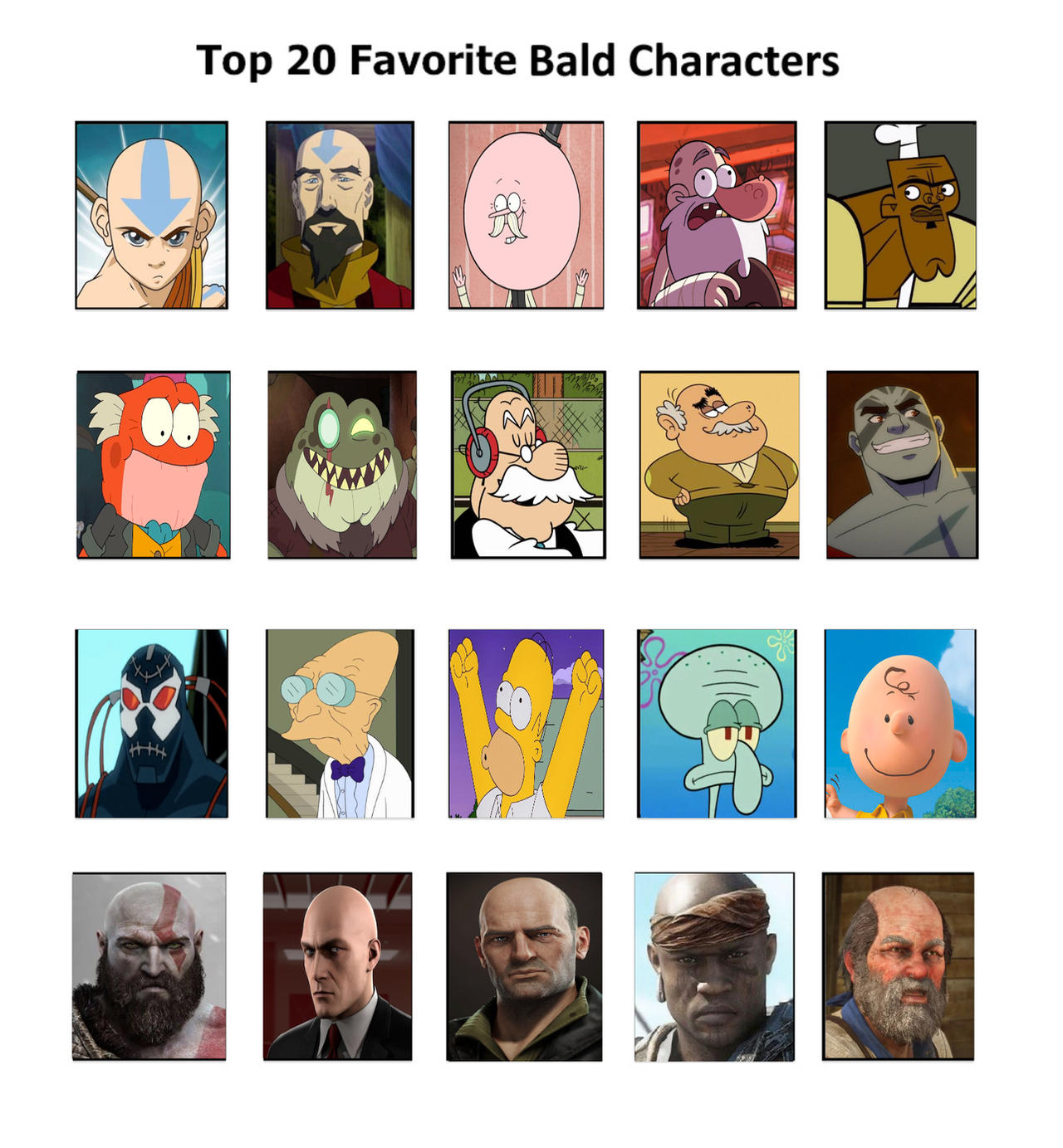Bald Characters: What Hair Loss Means In Stories
Detail Author:
- Name : Mrs. Greta Kunde
- Username : zelda35
- Email : runolfsdottir.landen@yahoo.com
- Birthdate : 2006-12-06
- Address : 83429 Fahey Mill North Cindystad, LA 39222
- Phone : +1-360-890-6365
- Company : Emmerich, Bartoletti and Davis
- Job : Construction
- Bio : Saepe maiores ut dolor natus ducimus. Sapiente culpa beatae ut eos dolores eos molestiae. Exercitationem doloremque et et.
Socials
linkedin:
- url : https://linkedin.com/in/shannon3125
- username : shannon3125
- bio : Et numquam sed sint delectus.
- followers : 6160
- following : 907
tiktok:
- url : https://tiktok.com/@hoegers
- username : hoegers
- bio : Quos dolor sit dicta quaerat pariatur et itaque. Dolorem vel quas enim est.
- followers : 2418
- following : 2268
facebook:
- url : https://facebook.com/shannon.hoeger
- username : shannon.hoeger
- bio : Veniam commodi qui esse quisquam id. Ut doloribus inventore quisquam qui.
- followers : 6297
- following : 2466
twitter:
- url : https://twitter.com/shannon1971
- username : shannon1971
- bio : Nobis eveniet quia nostrum et facere et. Consequuntur repudiandae reprehenderit non perferendis est qui. Optio aperiam excepturi modi aut sint sint aut rerum.
- followers : 4441
- following : 562
instagram:
- url : https://instagram.com/shannon_hoeger
- username : shannon_hoeger
- bio : Ut non atque eos ducimus eos maiores totam. Est in in minus et molestias ad rerum.
- followers : 895
- following : 1155
When we talk about **bald characters**, you know, we often think about people who simply have no hair on their heads. It's a very distinct look, and it carries a certain presence, apparently. This characteristic, which is a partial or complete lack of hair growth, can show up in many ways, and it's quite interesting to consider.
For many of us, hair loss is, in a way, just a fact of life. It’s a common experience, and it's something that can affect people in different stages of their lives, too. This natural process, or sometimes a sudden change, often shapes how we see someone, even in made-up tales.
Thinking about **bald characters** in stories gives us a chance to look at how hair loss, which is essentially the absence of hair, is shown. We can explore what it means for them, how it influences their journey, and what it tells us about the wider topic of hair thinning, so to speak. It’s more than just a visual detail; it really adds layers to who they are.
Table of Contents
- What is Baldness, Anyway?
- Why Hair Loss Happens, More or Less
- Recognizing Hair Loss, Just a Little
- Types of Baldness We See
- The Stages of Male Pattern Baldness, So They Say
- Hair Loss and Its Impact, In Some Respects
- Understanding Baldness in Stories
- Frequently Asked Questions About Baldness
What is Baldness, Anyway?
Baldness, as we often describe it, typically refers to an excessive amount of hair loss from your scalp. It's not just a little bit of hair falling out; it's a noticeable reduction in the hair that's there, you know. This can sometimes feel like a big change for someone.
It's really the partial or complete lack of hair growth on parts of the body, and it's a part of a much bigger discussion around hair thinning. So, it's not always about being completely smooth; sometimes, it's just about having much less hair than before, apparently.
While we usually notice it most on the head, baldness can actually happen anywhere on the body where hair grows. This means, in a way, that the absence of hair isn't just a scalp thing, though that's where it's most commonly observed, naturally.
There might be areas of skin that are completely bald, which means no hair at all grows there. This is a very clear sign of the condition, and it's something people often identify with the term, you see.
Sometimes, there could be associated skin disease or even scarring where the hair once was. This shows that hair loss isn't always just about the hair itself, but can be linked to other body conditions, too. It’s a bit more complex than it first appears.
Why Hair Loss Happens, More or Less
Hereditary hair loss, which often comes with age, is the most common reason people experience baldness. This means it often runs in families, and it's something that can be passed down through generations, so to speak.
The most common cause of baldness is androgenic hair loss. This type is very common, and it's something that affects many people as they get older, especially men, in some respects.
Male pattern baldness, for example, is most often the cause of hair loss in men. It's a very specific kind of hair loss that follows a particular pattern, and it's incredibly widespread, you know.
Around 95 percent of the time, hair loss is due to a condition called androgenetic alopecia. This is a big name for what many call male or female pattern baldness, and it shows just how common this specific type is, apparently.
For many of us, hair loss is, quite simply, a fact of life. It’s a natural process that a lot of people go through, and it's something that's been happening for a very long time, actually.
Recognizing Hair Loss, Just a Little
To tell if you're going bald, you might want to examine your hair in a mirror. This simple step can give you some clues about what's happening, so to speak, with your hair, you see.
Looking for a receding hairline could be a sign that you're going bald. This is where the hair at the front of your head starts to move back, creating a higher forehead, more or less.
However, if you're losing hair in patches, or in a way that seems unusual, that's something else to notice. It's not always just about the hairline; sometimes, it's about how the hair is thinning all over, too.
The degree and pattern of baldness varies a lot from person to person. What one person experiences might be quite different from another, even if the cause is similar, you know. It's not a one-size-fits-all situation.
Types of Baldness We See
The meaning of bald is essentially lacking a natural or usual covering. This can apply to hair, of course, but also to vegetation or even the nap on a fabric, apparently. It's a broad term for something that's missing its usual surface.
Baldness is the partial or complete lack of hair growth, and it's part of the wider topic of hair thinning. This means it covers everything from a little bit of hair loss to a completely smooth scalp, you see.
Male pattern baldness is a very common type of hair loss that affects men. It has a specific way of progressing, and it's something that many men will experience at some point in their lives, actually.
Some people, quite simply, prefer to let their hair loss run its course. They might not seek any treatments or interventions, choosing instead to accept the change as it happens, you know. This is a perfectly valid approach for many.
Unfortunately, hair loss may not always be easy to remedy. There aren't always quick fixes or simple solutions, and sometimes, the hair loss is permanent, so to speak. It can be a challenge for those who wish to reverse it.
The Stages of Male Pattern Baldness, So They Say
There are, apparently, seven recognized stages of male pattern baldness. These stages describe how the hair loss progresses over time, from early thinning to more extensive baldness, you know.
The early stages usually start when a person is in their 30s. This is often when the first signs become noticeable, like a slight receding hairline or some thinning at the crown, you see.
However, it's worth noting that some people have signs of baldness much earlier than their 30s. It really can begin at different ages for different individuals, which is why it's not always predictable, more or less.
Understanding these stages helps people, and perhaps even storytellers, to grasp the progression of hair loss. It shows that it's often a gradual process, not an instant change, in a way.
Hair Loss and Its Impact, In Some Respects
Hair loss, or the absence of hair, is usually most noticeable on the scalp. This is because our scalp hair is often a very prominent part of our appearance, and changes there are easily seen, apparently.
When we talk about **bald characters**, their lack of hair can be a powerful visual cue. It might suggest wisdom, age, strength, or even vulnerability, depending on how they are presented, you know.
The fact that baldness is a common experience for many people makes it a very relatable trait. When a character is bald, it can make them feel more real and grounded for the audience, in some respects.
It's interesting to consider how this physical characteristic, which is a fact of life for so many, is used to tell stories. It’s a very human detail, and it can add a lot of depth to a person, even a fictional one, you see.
This shared experience of hair loss, or knowing someone who has it, can create a connection between the audience and **bald characters**. It’s a quiet nod to a common part of human existence, actually.
Understanding Baldness in Stories
When we look at **bald characters** in stories, we're really looking at how a common human experience is portrayed. It’s about how this physical trait, which comes from things like hereditary hair loss with age, shapes their identity, you know.
The meaning of bald, which is lacking a natural covering, can be used to show different things about a character. It might suggest maturity, a certain kind of toughness, or simply a stage of life, apparently.
Since male pattern baldness is very common, and the early stages often start in one's 30s, **bald characters** can feel very authentic. They reflect the real experiences of many people around us, you see.
This characteristic, which is a partial or complete lack of hair growth, allows storytellers to create figures who are grounded in reality. It’s a very human detail that can make a character more relatable, in a way.
For more general information about hair loss and its various forms, you could look at resources like the American Academy of Dermatology Association website. They offer a lot of details about conditions such as androgenetic alopecia, which is the most common cause of baldness, naturally. Learn more about hair loss causes.
Thinking about why men go bald, and what you can do about it, is a topic many people wonder about. It’s something that comes up quite often in conversations about appearance and aging, you know.
The fact that hair loss may not be easy to remedy, or that some people prefer to let their hair loss run its course, shows different approaches to this natural process. It’s about choice and acceptance, too.
You can learn more about baldness on our site, and we also have information on hair thinning, if you're interested. These topics are very connected, and it's helpful to understand them together, so to speak.
Frequently Asked Questions About Baldness
What causes baldness, typically?
Baldness is most often caused by hereditary hair loss, which happens with age. This is also known as androgenic hair loss, and it's very common, especially male pattern baldness, you know.
Can baldness be reversed?
Unfortunately, hair loss may not always be easy to remedy. While some treatments exist, it's not always possible to completely reverse baldness, and some people simply prefer to let their hair loss run its course, apparently.
How can you tell if you are going bald?
To tell if you're going bald, you might examine your hair in a mirror. A receding hairline could be a sign, or if you're losing hair in specific patterns, that's something to notice, too.


